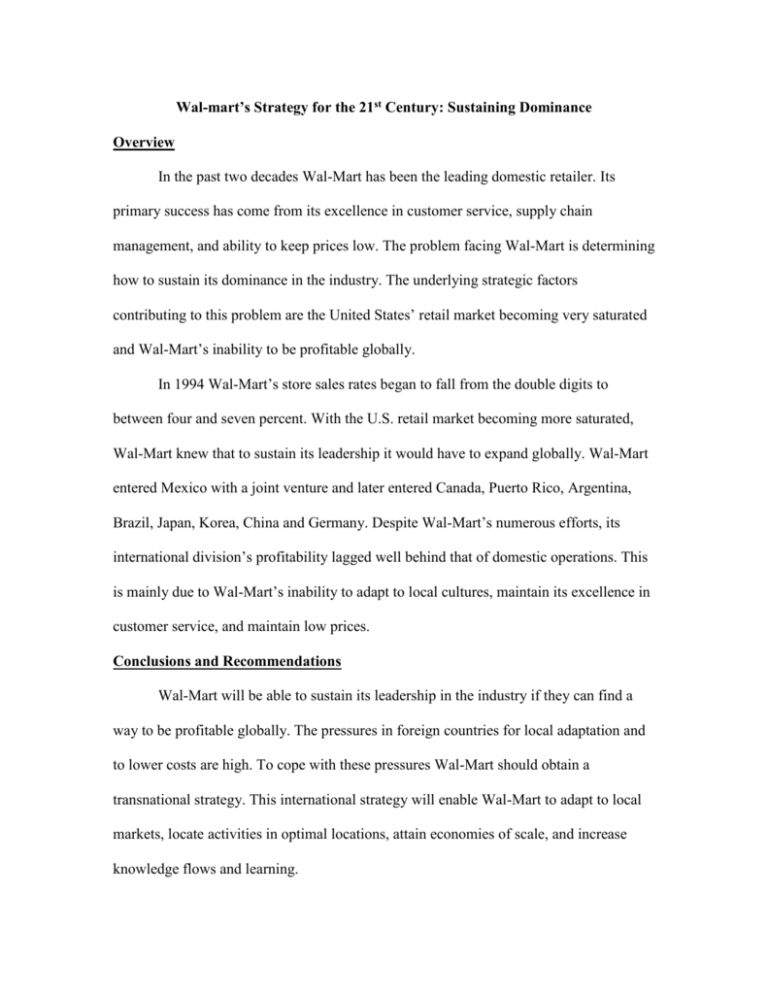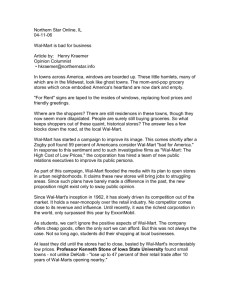Wal-mart`s Strategy for the 21st Century: Sustaining Dominance
advertisement

Wal-mart’s Strategy for the 21st Century: Sustaining Dominance Overview In the past two decades Wal-Mart has been the leading domestic retailer. Its primary success has come from its excellence in customer service, supply chain management, and ability to keep prices low. The problem facing Wal-Mart is determining how to sustain its dominance in the industry. The underlying strategic factors contributing to this problem are the United States’ retail market becoming very saturated and Wal-Mart’s inability to be profitable globally. In 1994 Wal-Mart’s store sales rates began to fall from the double digits to between four and seven percent. With the U.S. retail market becoming more saturated, Wal-Mart knew that to sustain its leadership it would have to expand globally. Wal-Mart entered Mexico with a joint venture and later entered Canada, Puerto Rico, Argentina, Brazil, Japan, Korea, China and Germany. Despite Wal-Mart’s numerous efforts, its international division’s profitability lagged well behind that of domestic operations. This is mainly due to Wal-Mart’s inability to adapt to local cultures, maintain its excellence in customer service, and maintain low prices. Conclusions and Recommendations Wal-Mart will be able to sustain its leadership in the industry if they can find a way to be profitable globally. The pressures in foreign countries for local adaptation and to lower costs are high. To cope with these pressures Wal-Mart should obtain a transnational strategy. This international strategy will enable Wal-Mart to adapt to local markets, locate activities in optimal locations, attain economies of scale, and increase knowledge flows and learning. Analysis External Environmental Conditions: Unfavorable. The U.S. retail market is becoming very saturated, so Wal-Mart needs to compete globally to sustain its leadership in the industry. The pressure for local adaptation in foreign countries is high. Wal-Mart prides itself on its excellent customer service. In order to have excellent customer service in a foreign country, Wal-Mart needs to understand the local culture very well. Local regulations and laws need to be clearly understood and followed. In Germany, Wal-Mart got bad publicity because they did not follow some important German laws and regulations. Internal resources and capabilities: Excellent and creating differentiation. Tangible resources. Wal-Mart operates the world’s biggest private satellite communications system. This system allows it to track sales, replenish inventory, process payments, and regulate store temperatures all in real-time. Wal-Mart already has built many stores in foreign countries. Now it just needs to manage them efficiently and adapt to the local culture. Intangible resources. Wal-Mart has exceptional brand reputation in the U.S. which is primarily due to emphasis on customer and community service. Wal-Mart also has excellent employee loyalty because it gives its employees profit-sharing and stock ownership plans. This helps employees to think and behave like an owner of the company. Financial Resources. Wal-Mart has plenty of financial resources because it is the United States’ leading retailer. The profits that the domestic stores produce will help Wal-Mart to improve its global operations. Capabilities. Wal-Mart’s core competencies are its supply chain management and customer value focus. The hub and spoke distribution system allows Wal-Mart to quickly replenish stock in its stores and to minimize unproductive space. Wal-Mart’s state of the art information systems track in-store sales and transmit the information to the suppliers. The customer value focus puts emphasis on customer service which helps to improve brand recognition. Wal-Mart can very easily transmit its supply chain abilities overseas but customer service in a foreign country requires extensive research into the local culture. Summary: Wal-Mart needs to successfully compete globally to sustain its leadership in the retail industry. Its current international division is no where near as profitable as the domestic division. The domestic success is primarily due to Wal-Mart’s excellent customer service, supply chain management, and brand recognition. Wal-Mart has not successfully adapted to foreign markets and this is why their customer service and brand recognition is not very strong in foreign countries. Implementation: Wal-Mart needs to obtain a transnational strategy because it will help Wal-Mart to deal with the pressures to adapt locally and keep prices low. This international strategy will allow Wal-Mart to obtain economies of scale, adapt to local markets, locate activities in optimal locations, and increase knowledge flows and learning. Wal-Mart’s knowledge and learning of foreign markets is very important if it wants to have excellent customer and community service in foreign countries. In addition to obtaining a transnational strategy, Wal-Mart should only enter into joint ventures until their knowledge of foreign markets is strong. Joint ventures with companies in foreign countries will help Wal-Mart to adapt locally. The foreign company can help Wal-Mart understand the country’s laws and regulations as well as customs and culture.





